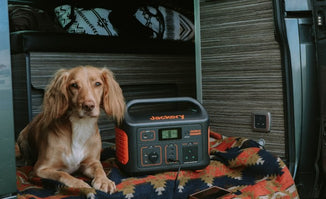The climate change issue is exacerbating every day. The situation in the UK is nothing different, as the country is encountering spikes in both the frequency and intensity of thunderstorms. Such disastrous storms give birth to threats such as power outages that can affect the whole daily life of the British people.
As an example, lightning strikes can damage electrical infrastructure and leave you with no power for long periods. In such situations, the enormous importance of home electric generators is more tangible because they can conserve electricity and keep you safe during power outages. They come with easy home generator installation to power integral appliances and medical equipment during thunderstorms.
Let’s find out why investing in a home electric generator or a portable power station is certainly worth it in the UK!
Thunderstorms in the UK: Frequency, Risks, and the Infrastructure
Thunderstorms in the UK are rather common. The majority of these thunderstorms are moderate, but severe ones can lead to substantial risks. That's why it is integral to understand the frequency and impact of these storms if you tend to prepare for potential hazards.
Frequency and Intensity of Thunderstorms in the UK
|
Region |
Frequency (Days/Year) |
Intensity Risk |
Notable Event |
|
Greater London |
15-25 |
High |
2012 (64,000 lightning strikes) |
|
Scotland (Highlands) |
5-10 |
Low |
Rare lightning storms |
|
South East England |
20-30 |
Moderate to High |
Spanish Plume (intense storm, large hail) |
The frequency and intensity of thunderstorms in the UK vary in different regions and time periods.
Thunderstorms are more rampant in southern and eastern England, including:
- Greater London
- Kent
- Sussex
- Essex
- Hertfordshire
- Cambridgeshire
- Suffolk
- Norfolk
On the contrary, northern and western regions—like parts of Scotland and Northern Ireland—are less prone to experiencing annual thunderstorms.
On average, throughout a year, it is safe to say that the UK experiences between 200,000 and 300,000 lightning counts. A typical thunderstorm day may contain as many as 10,000 lightning strikes. Some days, this number may even be recorded as 50,000 strikes. For instance, almost 64,000 lightning strikes were recorded only on June 28, 2012[1].
Some studies have shown a very slight reduction in the number of days with thunderstorms in recent decades. However, annual records are highly variable and it’s rather tough to ensure a clarified trend regarding this.
Thunderstorms in the UK are generally moderate in intensity. However, severe thunderstorms are not very rare. For example, the Spanish Plume phenomenon has occasionally led to intense storms containing large hail and destructive winds[2]. Yellow weather warnings are a normal thing for large areas of England and Wales.
Risks of Thunderstorms in British Homes
Thunderstorms in the UK can give birth to noticeable risks to homes and inhabitants. For example, lightning strikes can lead to structural damage, fires, and injuries. Roughly 30-60 people in the UK are struck by lightning every year, leading to almost 3 deaths[3].
What’s more, lightning can lead to power surges too, which may result in damage to electrical appliances and systems. That is why it is suggested that you unplug unnecessary appliances during thunderstorms.
Furthermore, severe storms can even lead to power outages as they damage infrastructure. As an example, Storm Arwen in 2021 cut the power to thousands of consumers for several days.
Vulnerability of the UK's Electrical Infrastructure During Thunderstorms
The UK's electrical infrastructure is powerful, but it may face tough challenges during harsh weather conditions like thunderstorms.
In the case of overhead power lines, strong winds and falling debris may harm the lines, which can lead to power outages. For instance, maximized storm and wind speeds can enormously affect overhead power lines.
What’s more, lightning strikes can damage transmission equipment, thereby leading to disruptions in power supply. Currently, continuous assessments are managed to maintain the country’s resilience of critical infrastructure against such harsh weather conditions.
To handle these risks, home electric generators can deliver a dependable backup power source, particularly during outages caused by thunderstorms. House generators supply constant power and mitigate the impact of power disruptions, which can be specifically more considerable for those more dependent on electrically powered medical equipment.

How to Stay Safe During Thunderstorms
Thunderstorms can be hazardous. That's why it is critical to guarantee your safety during intense weather conditions, particularly in the UK where unanticipated storms are rampant.
Regardless of where you are during a thunderstorm—indoors, outdoors, etc.—it is integral to understand how to shield yourself and your home. Also, preparation for power outages and acquiring a dependable home electric generator can be a game-changer.
Indoor Safety Tips
It is often the safest place to be indoors in the case of facing a thunderstorm. However, it doesn't mean you're completely safe.
The primary thing to do in such cases is to stay away from windows and doors. Interestingly, lightning can penetrate cracks and gaps. Also, high winds can convert loose objects into notable hazards. Remember not to stand near the glass, which is prone to shattering in extreme weather conditions.
Speaking of electrical appliances, the key point is to unplug unnecessary electronics such as televisions, computers, and gaming consoles. This is critical because lightning can lead to surges in power, hence the damage to electronic devices.
If you own a home electric generator, it can protect you. However, precautions are still crucial. A home generator functions as a backup power when the mains are down, but you still have to unplug unnecessary devices during a storm. That's because lightning can even impact household generators with sudden voltage spikes.
Outdoor Safety Tips
If you end up outdoors during a thunderstorm, the most critical task is to find shelter. However, if getting indoors isn’t possible at the moment, there are some crucial precautions to consider.
First of all, you need to stay away from tall trees and open fields. As you know, lightning is highly prone to striking the tallest objects. Therefore, trees, lampposts, and even lone persons in open spaces are highly vulnerable. Instead of that, you can crouch low to the ground and minimize contact with the earth.
What’s more, you need to remember that using electrical devices such as mobile phones or portable radios isn't a wise decision if they're connected to some external power source.
Dealing with Power Outages
Power outages are the dark side of any thunderstorm, especially in the UK, where the power grid is highly vulnerable to storms. That's why it's a must to prepare for such outages beforehand.
One of the first things to do is to position torches and battery-operated radios somewhere easily accessible. Also, you need to avoid using candles so you can stay away from the risk of potential fire.
That's where investing in a powerful home electric generator can be a true game-changer. These generators supply backup power to help you keep your critical appliances running during a thunderstorm.
If you're serious enough regarding storm preparation, a home electric generator helps you have easy access to power even during long outages. If you own a smaller home or have faced short-term disruptions, a portable power generator or even a battery-powered backup system can be adequate.
Best Practices for Using Home Electric Generators During Thunderstorms
For the majority of households in the UK, employing a home electric generator during a thunderstorm is a beneficial solution to cope with power outages. Still, it is integral to find out how to use the generator safely to prevent accidents and guarantee a steady power supply.
Below, we aim to discuss the best practices for choosing, setting up, and operating an appropriate home electric generator during thunderstorms.
Choosing the Right Generator
The primary step in employing a safe home electric generator is to choose the right one that fits your needs. You may find multiple types of generators on the market—diesel generators, solar generators, and more. That's why picking the correct type of generator hinges on the size of your home and your power demands during outages.
You need to consider the type of your fuel. Options include gasoline, diesel, or even solar-powered generators. However, solar generators are a better choice cause they're environmentally friendly, silent, and require little maintenance. In the end, the ultimate choice of the right generator hinges on your energy demands, budget, and how frequently you tend to use it.
Safe Generator Setup
An integral side of using a home electric generator is making sure it’s installed safely. Accurate installation of the generator should be managed by an expert. That's because incorrect installation might lead to severe issues like electrical fires.
It’s crucial to make sure your generator sits on a stable and dry surface. It should be protected against rainwater because wet conditions can maximize the risk of electrocution.
What’s more, routine upkeep and testing are critical. Before a storm arrives, you have to test your device to see if it can operate correctly. It’s suggested that you regularly change the oil, check fuel valves, and look for wear and tear to keep your generator in its top status.
Operating Safely During a Storm
After the proper installation, you need to know how to operate the device safely during a storm. First of all, make sure your generator is fully charged. If you run out of power in the midst of an outage, you have to expect dangerous situations, especially if you depend on your device for essential devices.
During thunderstorms, you should use your generator to power only the most integral appliances like lights, refrigerators, and medical equipment. Overloading your generator may lead to malfunctions or even a breakdown when you need it.

Jackery: The Ideal Solution for Thunderstorms
When it’s all about remaining safe during thunderstorms, Jackery’s name is heard as a dependable brand that presents powerful, reliable home electric generators. The Jackery Solar Generator 2000 Plus is a wonderful example of these generators as it delivers comprehensive features and spectacular performance.
One crucial benefit of the Jackery Solar Generator 2000 Plus is its expandable capacity. Since it can variably deliver capacities between 2 kWh and 12 kWh, the generator can impressively handle short and even prolonged power outages without electricity.
Even during the worst storms, the Jackery Solar Generator 2000 Plus is able to power everything from primary household appliances to heavy-duty devices up to 3000W. This makes this generator a smart choice for UK households where unanticipated weather conditions have turned into something common.
Another notable feature of the Jackery Solar Generator 2000 Plus is its ultra-fast solar charging capability. Since the generator is armed with state-of-the-art IBC technology, it can be fully charged in just 2 hours. This helps you be always prepared for thunderstorms, even when you face outages.
This fast charging capability makes the Jackery Solar Generator 2000 Plus a worthwhile asset, particularly for homes that depend highly on critical medical or communication devices. Also, the device is equipped with an enduring LiFePO4 battery that comes with a 10-year lifespan.
The ingenious ChargeShield technology in the Jackery Solar Generator 2000 Plus sweetens its battery life by 50%. Plus, the incredible 5-year warranty delivers even more comfort for British homeowners who are looking for a dependable power source.
Conclusion
Jackery delivers a dependable solution for power outages when storms hit in the UK. We offer a broad set of home electric generators—including the Jackery Solar Generator 2000 Plus—to make sure households around the country can remain connected to power and safe when the lights go out.
Our household generators come with steady backup power and effortless generator installation procedures. Our generators are a wonderful choice even for the most disastrous storms, whether you go with our portable power stations or our mighty house generators.
That's to say that our company’s home electric generators are a must-have option for storm preparation across the UK. With Jackery, you will always be able to stay secure during the toughest thunderstorms.
References
- Thunderstorms in the UK. Available at: https://www.torro.org.uk/research/lightning/thunderstorms-UK(Accessed: 8th, October)
- Spanish Plume. Available at: https://en.wikipedia.org/wiki/Spanish_plume(Accessed: 8th, October)
- Lightning at Leisure. Available at: https://www.rospa.com/leisure-water-safety/leisure-safety/lightning(Accessed: 8th, October)


































































































